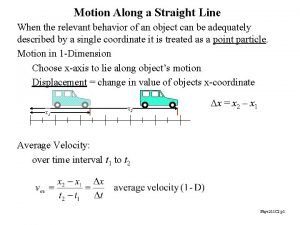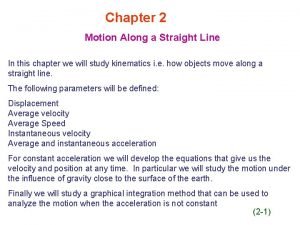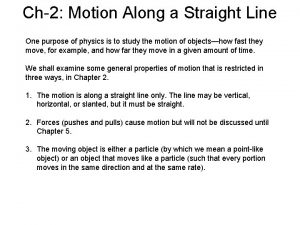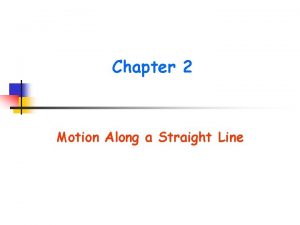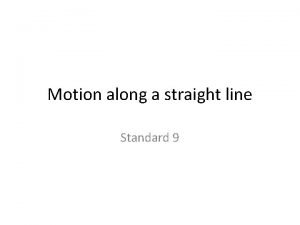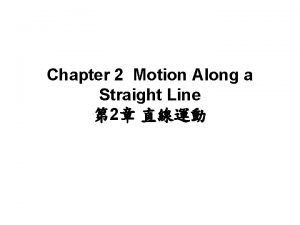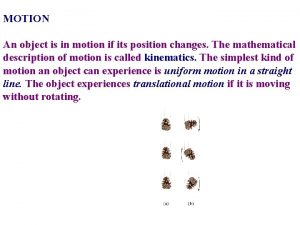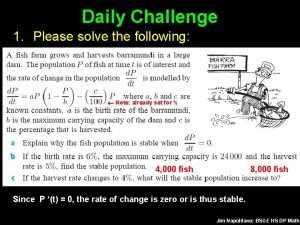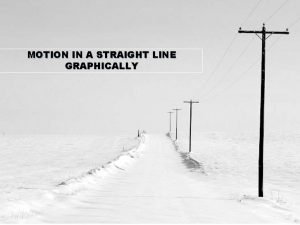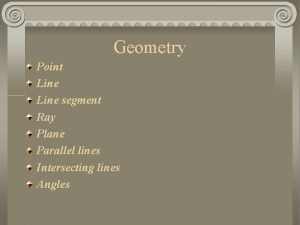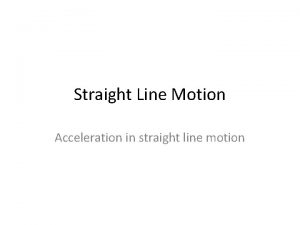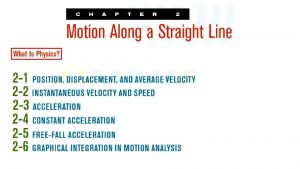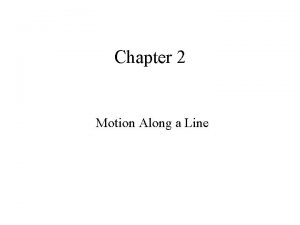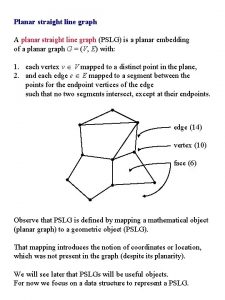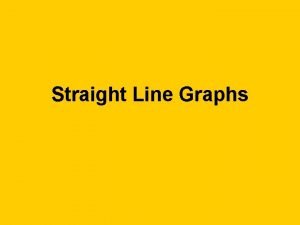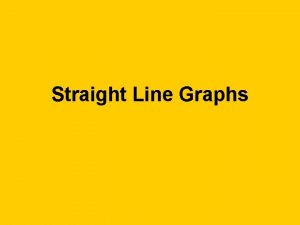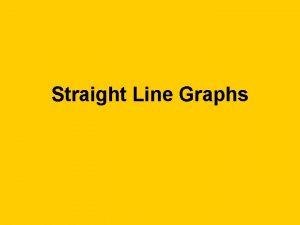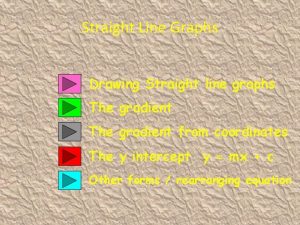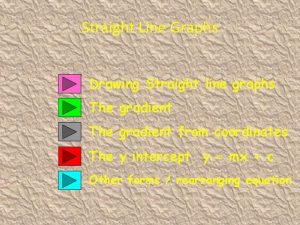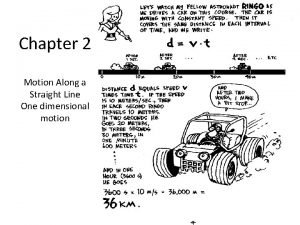Motion along a straight Line In order to












- Slides: 12

Motion along a straight Line: In order to describe an objects motion you need to be aware of where it is located at different times. In other words, we need to know an objects position as time is passing. Motion Diagrams: a series of images showing the positions of a moving object at equal time intervals. Particle Model: a motion diagram where the moving object is assumed to be a small point located at the center of the object. Note that in order to use a particle model, the distance the object moves needs to be much greater than the size of the object. See the diagram below where a box has moved to from left to right over 20 s. This would be a Motion Diagram. t=0 s t=5 s t = 10 s t = 15 s t = 20 s However if the box was replaced with a series of dots located at the center of the box, then it would be a Particle Model.

Coordinate System: When you define the starting position and the starting time, you are defining the coordinate system. Origin: The origin is the position where both variables being measured have values of zero. Vectors versus Scalars: a scalar is a quantity that only has magnitude while a vector has both magnitude and direction. Examples of scalars are: mass, time, length, volume, etc… Examples of vectors are: position, velocity, acceleration, etc…. Position and Distance: an object’s position can be represented by drawing an arrow from the origin to the object’s current location. The length of the arrow is a measure of the distance that the object is from the origin. t=0 s t=5 s t = 10 s t = 15 s t = 20 s 0 m 12 m 24 m 36 m 48 m Notice that the object’s distance ends up being 48 m from the origin (this is length-a scalar), but the arrow that points to the object’s current location is called the position-a vector

Adding Scalars and Vectors: adding scalars is just normal addition of numbers that have the same units like 6 in + 3 in = 9 in; adding vectors requires you to take the direction of the arrow into account when adding the magnitudes together; this is easy when we work in one dimension but becomes more complicated when we additional dimensions. Resultant: the answer when we add two or more vectors is called the resultant and it is also a vector. If an object moves from left to right 36 m and then later travels from left to right 12 m, what would the resultant be for the position of the object? Resultant 0 m 12 m 24 m 36 m 48 m If an object moves from left to right 36 m and then later travels from right to left 12 m, what would the resultant be for the position of the object? Resultant 0 m 12 m 24 m 36 m 48 m

Time Interval: the difference between two times is called a time interval The equation form for time interval is: Dt = tf – ti where D is delta and means change in tf is the final time ti is the initial time Displacement: difference between two positions of an object is called displacement The equation form for displacement is: where D is delta and means change in df is an object’s final position di is an object’s initial position Dd = df – di Note that Displacement is a vector quantity, but Time Interval is a scalar quantity. Example: Find the displacement of an object during the time interval from 5 s to 20 s. di df Resultant t=0 s t=5 s t = 10 s t = 15 s t = 20 s 0 m 12 m 24 m 36 m 48 m

Position versus Time Graphs: graphs showing an object’s position in time. Time will be plotted on the X-axis and Position will be plotted on the Y-axis. Position (m) 150 125 100 75 50 25 0 -25 0 1 2 3 4 5 6 7 8 -50 Could you write a data table that could be used to create the graph? Time (seconds) Draw a particle diagram that would clearly illustrate the motion of the object described by the graph above. t=7 s t=6 s t=5 s t=4 s t=3 s t=2 s t=1 s t=0 s -50 m -25 m 0 m 25 m 50 m 75 m 100 m 125 m

If the positive direction is called East and the negative direction is called West, answer the following questions concerning the graph below. a) Which direction was the object traveling? b) At what time was the object 25 m East of the origin? c) Where was the object at t = 3 s? 150 Position (m) 125 100 75 50 25 0 0 1 2 3 4 5 6 7 8 -25 -50 Time (seconds) t=7 s t=6 s t=5 s t=4 s t=3 s t=2 s t=1 s t=0 s -50 m -25 m 0 m 25 m 50 m 75 m 100 m 125 m Note: the particle diagram may make answering some of these question easier.

See the Challenge Problem on page 40 Position (meters) 20000 15000 10000 Phil Oliver Niram 5000 0 0 10 20 30 40 -5000 Time (minutes) 50 60 70

Position Versus Time Graphs Continued (Classwork Problem). Create a position versus time graph for the following situation. Student 1 starts walking north from point A at 8: 00 at a rate of 3. 5 mi/hr. Student 2 starts jogging from point B that is 2. 5 mi south of point A at 8: 30 at a rate of 4. 75 mi/hr. Use your graph to answer the following questions; 1) How far apart were the two students at 9: 00? 2) Which student would be ahead at 10: 30? 3) At what time will student 2 pass student 1? 4) What time will it be when student 2 passes student 1? Position (mi) 20 Click to see graph. 15 10 Student 1 Student 2 5 0 0 1 2 3 -5 Time (hr) 4 5 6

Average Velocity (ῡ), Average Speed (ῡ), and Instantaneous Velocity (υ) Note that velocity is a vector quantity while speed is a scalar quantity. For example: the car is travelling 55 mi/hr the car is travelling east at 55 mi/hr this is a speed this is a velocity Average velocity is the change in position divided by the time interval: (note: the bar above the symbol means “average” and the bold font indicates a vector quantity) ῡ = Dd/Dt Average speed is the absolute value of the change in position divided by the time interval: another way to say this is that the average speed is the absolute value of the slope of the displacement versus time plot for an object. ῡ = |Dd|/Dt Instantaneous velocity is the speed and direction of an object at any instant. υ

Average Velocity (ῡ) shown on a motion diagram 0 m 25 m 50 m 75 m 100 m 125 m t=0 s t=1 s t=2 s t=3 s t=4 s t=5 s In the motion diagram above, the object moves 25 m to the right each second (represented by the red dots). Since Velocity is a vector quantity, we need to show magnitude and direction, so we use arrows-the length of the arrow represents magnitude and the direction it points is the direction of the motion. To include velocity on a motion diagram, a series of arrows would be used showing the average velocity at each point.

Position versus Time 1750 Since this graph plots position versus time, the slope of this line is velocity. This means we can interpret the equation: y = mx + b as 1500 Position (m) 1250 1000 750 500 250 0 d = ῡt + di -250 -500 0 10 20 30 40 50 60 70 80 Time (s) The graph above is a line with the following equation: y = 25 x – 250 This is the y = mx + b format where y is the vertical axis value, m is the slope of the line, x is the horizontal axis value, and b is the y value when the x value is zero (called the y-intercept). d = ῡt + di is called an Equation of Motion for Average Velocity where d is the position at time t, ῡ is the velocity (slope), t is the time and di is the initial position of the object.

Equations of Motion for Average Velocity (d = ῡt + di) can be used to solve problems. Answer the following questions based on the equation below. Assume that time is in minutes and positions are in meters and the positive direction is east. d = 3. 8 t + 16. 6 Where is the object located after 35 minutes? What is the velocity of the object (include units)? How far from the origin was the object when we started recoding the time? How long will it take for the object to be 426 m east of the origin? Can the object ever be located West of the origin, if so how-explain?
 Motion along a straight line definition
Motion along a straight line definition Kinematics: motion along a straight line
Kinematics: motion along a straight line Motion along a straight line definition
Motion along a straight line definition Motion along a straight line formulas
Motion along a straight line formulas Motion along a straight line formulas
Motion along a straight line formulas Straight-line motion
Straight-line motion Chapter 2 motion along a straight line
Chapter 2 motion along a straight line An object travels back and forth along a straight line
An object travels back and forth along a straight line Second equation of motion
Second equation of motion Math lesson
Math lesson Straight line motion equations
Straight line motion equations Collection of points along a straight path
Collection of points along a straight path Via optica
Via optica
